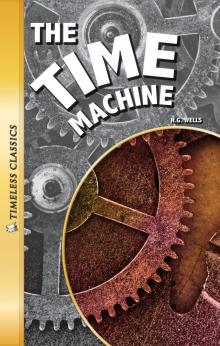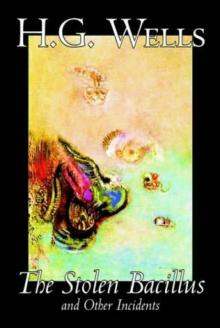- Home
- H. G. Wells
The Country of the Blind and Other Stories Page 2
The Country of the Blind and Other Stories Read online
Page 2
Patrick Parrinder
Introduction
From the Days of Future Past
H. G. Wells, Bertie to his parents and H.G. to his friends, was, with Jules Verne, the person who gave us the scientific romance – the forerunner of that branch of literature we now know as science fiction. His short stories, and his proto-science fiction novels, have lasted and are still read today, while many of the mainstream novels he considered more important and significant are gone and, for the most part, forgotten, perhaps because they were very much of their time, and swallowed by the change in time, while some of the science fiction and fantasy novels and tales are, for all their late Victorian or Edwardian settings, quite timeless.
Wells’s novels set a pattern. The madman on his island making people out of animals, the journey through time or into space, all have been imitated, consciously or unconsciously, ever since, taken as templates for stories by hundreds, perhaps thousands of other authors: the arrival in a small Sussex village of an Invisible Man – his self-imposed confinement to his room, the brilliant but forgettable hero barely introduced until we are past the hundredth page, the revelation and explanation of poor, mad albino Griffin, is not just the story of The Invisible Man, but it is the shape, the recipe for a thousand other stories in which there are Some Things Mankind Was Not Meant To Know, in which the borders between science and madness are frayed. Wells’s science fiction books were novels of ideas as much as they are novels of people; while arguably they are also all novels of class, either metaphorically (as Dr Moreau creates an underclass of beast-men in The Island of Doctor Moreau; or The Time Machine’s Traveller encounters in the distant future an effete upper class and a monstrous lower class) or literally – crazy Griffin is a lower-middle-class creature out of his depth.
The short stories, for the most part, tend to be something else. Something unique to Wells.
It has been said that the Golden Age of Science Fiction is when you were twelve years old, and it could certainly be argued that Wells wrote his short stories for twelve year olds, or for the twelve year olds inside adults. His fabulism tends to be asexual, unproblematic, straightforward. (A personal admission: I read most of these stories first as an eleven-year-old boy. I found a thick, red-covered collection of the Science Fiction Short Stories of H. G. Wells on a shelf in a schoolroom and read it several times over the next two years, fascinated and transported. The tales were old, undoubtedly, but they did not feel dusty or anachronistic or even outdated. The flowering of the strange orchid disturbed me and the unsatisfactory nature of the Magic Shop left me wondering.1 It was good.)
These are tales of obsession and revelation and discovery. Some of them swash, sometimes, buckle and adventure. Mostly, however, they remind us that they are, in some sense, eyewitness reports, with all the limitations and power of such. We are told repeatedly what was seen, and only a little more, and left to draw our own inferences. We are left to wonder. Was a man translated through the fourth dimension, and did he see hungry spirit-creatures there? Was that what he truly saw? Did man-eating cephalopods come ashore on stolid British beaches, to feast on human flesh? What was seen worshipping in the depths of the ocean abyss? How did the crystal egg arrive in the shop, and where is it now? We know only what was seen, and that, in its way, is convincing.
There is an old saw that in a short story one thing happens. Wells’s short stories exemplify this. His writing is effective: as good as it needs to be, with little in the way of grace notes. Still, the best of the stories are haunting in their implications.
All too often they are tales of failed revelation. In Wells’s world the fruit of the tree of knowledge is not eaten – not because of fear or difficulty, but because of embarrassment -and over and over again, knowledge of something equally as magical (the secret of making diamonds,2 an egg that shows us life on Mars, the formula for invisibility) is lost to the world. At the end of many of these stories the world is unchanged, and yet it could have been changed utterly and irrevocably. If one of the social functions of science fiction is to prepare us for change; Wells’s stories began that process. Darwin adumbrated change. Wells was a scientist or at least, when young, a science teacher and science writer, taught by a disciple of Darwin’s, and he was not scared by ideas or by the practicalities of science. Wells used his fiction to illuminate change, celebrating it as he warned of what change could mean.
The most successful Wells short stories do not read like stories, not really. They are anecdotes and journalism: carnivorous squid arrive in a tale that feels like an article from a turn-of-the-century scientific paper, while the ants, armed with poison, conclude their tale fifty years away from arriving in Europe (in those slow, comfortable days before container ship and jet plane). It’s not a weakness – indeed, it’s where these stories derive a significant amount of their power and effect from, and it’s one of the places that these stories can be seen as early branches on the science fiction family-tree: part of SF is the literature of ideas, and several of these stories are almost pure idea, uncluttered by plot or narrative. Still, by today’s standards (and those of the time Wells was writing) this was not on. They were not proper short stories – a criticism that Wells took to heart in his 1911 introduction to The Country of the Blind and Other Stories, when he says that
we suffered then, as now, from the à priori critic. Just as nowadays he goes about declaring that the work of such-and-such a dramatist is all very amusing and delightful, but ‘it isn’t a Play’, so we had a great deal of talk about the short story, and found ourselves measured by all kinds of arbitrary standards. There was a tendency to treat the short story as though it was as definable a form as the sonnet, instead of being just exactly what anyone of courage and imagination can get told in twenty minutes’ reading or so. It was either Mr Edward Garnett or Mr George Moore in a violently anti-Kipling mood who invented the distinction between the short story and the anecdote. The short story was Maupassant; the anecdote was damnable. It was a quite infernal comment in its way, because it permitted no defence. Fools caught it up and used it freely. Nothing is so destructive in a field of artistic effort as a stock term of abuse. Anyone could say of any short story, ‘A mere anecdote’, just as anyone can say ‘Incoherent!’ of any novel or of any sonata that isn’t studiously monotonous. The recession of enthusiasm for this compact, amusing form is closely associated in my mind with that discouraging imputation. One felt hopelessly open to a paralysing and unanswerable charge, and one’s ease and happiness in the garden of one’s fancies was more and more marred by the dread of it. It crept into one’s mind, a distress as vague and inexpungible as a sea fog on a spring morning, and presently one shivered and wanted to go indoors.… It is the absurd fate of the imaginative writer that he should be thus sensitive to atmospheric conditions.3
Wells seems painfully aware here that many of his most effective short stories were not explorations of character and event, and was uncomfortable with this. He need not have been. The truth is that they work because they lack, sometimes, plot, often, character. What they have instead is brevity and conviction. Arthur Conan Doyle’s eleven-thousand-word story ‘When the World Screamed’ (1928) in Wells’s hands would have been a journalistic report of half the length, devoid of people. It would have been only about the event. The world of the finest of Wells’s short stories is one of possibilities, of breakthrough in science or society or of the Unknown, which reimagine the world.
The stories, particularly the more fantastic of them, are most easily read as if they were postcards from an alternate future that is already long past. Many of these stories are about futures and changes that have long since been carried away by time and memory: it is hard to remain on the cutting edge well over a century after the stories were written.
Wells described the art of the short story as
the jolly art of making something very bright and moving; it may be horrible or pathetic or funny or beautiful or profoundly illuminating, having only this
essential, that it should take from fifteen to fifty minutes to read aloud. All the rest is just whatever invention and imagination and the mood can give – a vision of buttered slides on a busy day or of unprecedented worlds. In that spirit of miscellaneous expectation these stories should be received.
And that suggestion holds as true now as when he wrote it.
(The reader is advised that some plot details are given away in this section.)
‘The Lord of the Dynamos’ – Here we meet the New Theology, in a tale of ‘a blackleg, and Azuma-zi, who was a mere black’. Azuma-zi, who has come to England from the East, sees the Dynamo as ‘greater and calmer even than the Buddhas he had seen at Rangoon’. A reminder of attitudes and language we would no longer view as reasonable, and a story that presaged one of the themes of science fiction: that our machines, if we permit them, can become our gods.
‘The Remarkable Case of Davidson’s Eyes’ – An example of Wells’s technique of presenting the reader with an impossibility and then buttressing it with just enough detail to convince.
‘The Moth’ – Science fiction in that it is a fiction about scientists, but it takes on the mantle of a ghost story and then, in its view of the descent into madness, shades gently into the weird tale. As our scientist accepts that only he can see the moth he embraces his madness, and that is true horror.
‘A Catastrophe’ – A heartbreakingly biographical story, but one that gives a happy ending to a world that in Wells’s own life ended in disaster. A what-if story. In reality Wells’s father lost his shop, his mother went into service. Here is fiction as time-travel, a way to fix the unfixable.
‘The Cone’ – A small, tragic, eternal triangle (a cone is a triangle in three dimensions). Reminiscent of the tales of horror and revenge told in the American E. C. Comics line in the 1950s, in which a metaphor is taken literally and lethally: blood boils in the veins of both the artist and the cuckolded husband, and in the case of one of them it is not merely a figure of speech. With its machinery dominating the landscape, the story reminds us of ‘Lord of the Dynamos’, and the end can be seen as a similar act of sacrifice.
‘The Argonauts of the Air’ – A small piece of science fiction, now consigned forever to an alternate past. A fascinating little story in which Wells’s every guess and instinct was wrong, save for his understanding that mankind would be travelling by air, and sooner than most people believed. Despite the death at the end of the story, this is not shaped as a tragedy. This could be a space-flight story, a little too early: while Wells was wrong about the early days of heavier-than-air flight – it wasn’t a millionaire’s game, but a relatively cheap playing-field – he would have been right about space travel, which is a billionaire’s game of the kind where one can imagine the gilding of aluminium.
‘Under the Knife’ – A death that crosses the universe, in a story that is predicated upon changes in scale, as we gaze upon the handiwork, and the hand (although not the face) of God.
‘A Slip under the Microscope’ – SF in the sense that it is a fiction with scientists in it; a fiction that reminds us of Wells’s own early failure to graduate. Again, in every sense, a tale of class. Again, a tale of rivalry, here played out as a morality play in which success and failure mean two very different things to two very different people.
‘The Plattner Story’ – Again, an anecdote, in which we find ourselves convinced of its truth by the initial shock of the reversal of right-and-left-handedness of things, as if Plattner has been mapped through another dimension and returned to us in mirror-form (the branch of chemistry known as chirality). We see ghosts and a nine days’ wonder (there are many nine days’ wonders in Wells’s tales – Here, we are told in one way or another, several times, as the stories begin, is something remarkable – something that has already been replaced in the imagination of the populace, and now I shall tell you something about it you did not know).
‘The Story of the late Mr Elvesham’ – A body swap tale, as poor Eden is subsumed into the mysterious Mr Elvesham. It’s proto-SF that shades into pure horror.
‘In the Abyss’ – Again, a fragmentary, almost anecdotal piece, in which we gain a glimpse of a world deep beneath our own, and lose it once more.
‘The Sea Raiders’ – A tale I last read when I was twelve or thirteen. I remember the fear I felt then at the incursion of something deeply alien and dangerous in places I knew and was familiar with. Another battle in the War of the Worlds, although the threat comes from below, not from Mars. The style is journalistic, the intent purely to convince. The inconclusive nature of the ending adds to the feeling that this happened, or could have happened, just as Wells describes.
‘The Crystal Egg’ – The nature of seeing is a theme that echoes through many of Wells’s short stories and here (as in ‘The Remarkable Case of Davidson’s Eyes’) we encounter seeing at a distance. Once more a revelation that is only partially revealed, wrapped in a series of mysteries and, eventually, lost due to human fallibility, not malevolence. The glimpse of another world the tale (and the Egg) gives us is otherwordly and haunting, and poor Cave, the small businessman on the edge, sustained by his visions of another world, is a perfectly Wellsian character, giving an odd humanity to what would otherwise be an anecdote about an interplanetary television before its time.
‘A Story of the Stone Age’ – Now an almost forgotten story, it feels like an aborted novel, one that should have continued. Wells is an early explorer of a genre that others have returned to over the years – that of conceptual breakthrough in Stone Age man, in a time when all ideas are new. The hero becomes the first man to ride a horse, and he creates an early doomsday weapon, a club inset with lion’s teeth. While the story he gives us is satisfying, it still reads like something Wells meant to go back to and complete, a book that would have been The Clan of the Cave Bear4 of its day.
‘The Star’ – Wells enjoys changing scale, the slow pull back from the personal to the cosmic, and employs the technique here to great effect.
‘The Man who could work Miracles’ – Justly famous, often dramatized – this story has been a film, and adapted many times for television and radio. Like many of Wells’s fantasies, it loops back to where it began.
‘A Dream of Armageddon’ – Wells built a ‘future history’ – a consistent history of the future, in which he set several stories. This tale of a dream of events that have not yet happened, of future war and political and personal disaster, and of death, fits vividly into that history.
‘The New Accelerator’ – A remarkably joyful story of super speed and mischief. A playful story – for once in a Wells tale the Accelerator is neither lost nor destroyed, nor does it result in madness and death. Instead we end in possibility.
‘The Truth about Pyecraft’ – In the main, the narrator is indistinguishable from Wells. This is not true of the narrator of ‘Pyecraft’, who is a thin man, of Indian descent. Pyecraft himself, who thinks he wants to lose weight but actually wants not to be fat, is a real character, in a Bunterish sort of way, a marvellous and memorable ‘great, fat, self-indulgent man’. It’s a genuinely funny fantasy story which leaves us – almost – where it began.
‘The Country of the Blind’ – For me, one of the most interesting of Wells’s stories, partly because of his need to rewrite the story decades later, or rather, his need to give it a new ending. It’s an unusual story in many ways: in its easy reversal of the common saw that in the Country of the Blind, the one-eyed man is king; in the inability of the protagonist to communicate; in the way that entire concepts become meaningless when the sensory information they carry becomes redundant.
The first iteration of the story (1904, given here) follows the classic Wells short-story pattern of an encounter with the impossible, and an unsatisfactory resolution, the story convincing us by its own awkwardness.
The later version (1939, missing the last 300 words and with an additional 2,000 words) is both more and less satisfactory – the convincing anecdot
e now becomes a real short story. The pattern is more familiar. Now the sighted man does more than simply escape – his vision gives him the power to return to warn the villagers, Cassandra-like, of their impending doom; the ending contains real love between a man and a woman, and the thrust of the story has changed from reportage to art. Each version of the story is perfectly satisfying, but the immediacy and conviction of the first ending is exchanged for something that demonstrates that, had Wells had the spirit for it, he might in later life have produced some remarkably moving short stories of the fantastic. (It was not that he was not asked, nor that he did not have a market. More that the fecundity of ideas went away, and that his mind and attention went elsewhere. As Wells explained, in apology, ‘I find it a little difficult to disentangle the causes that have restricted the flow of these inventions. It has happened, I remark, to others as well as to myself, and in spite of the kindliest encouragement to continue from editors and readers. There was a time when life bubbled with short stories; they were always coming to the surface of my mind, and it is no deliberate change of will that has thus restricted my production.’)

 Ann Veronica: A Modern Love Story
Ann Veronica: A Modern Love Story The Time Machine
The Time Machine The First Men in the Moon
The First Men in the Moon The Stolen Bacillus and Other Incidents
The Stolen Bacillus and Other Incidents The War of the Worlds
The War of the Worlds The Invisible Man: A Grotesque Romance
The Invisible Man: A Grotesque Romance The Island of Doctor Moreau
The Island of Doctor Moreau The Door in the Wall, and Other Stories
The Door in the Wall, and Other Stories The Best Science Fiction Stories of H G Wells
The Best Science Fiction Stories of H G Wells The Sea Lady
The Sea Lady The Wonderful Visit
The Wonderful Visit Love and Mr. Lewisham
Love and Mr. Lewisham Marriage
Marriage Tales of Space and Time
Tales of Space and Time The War of the Worlds (Penguin Classics)
The War of the Worlds (Penguin Classics) Twelve Stories and a Dream
Twelve Stories and a Dream The Food of the Gods and How It Came to Earth
The Food of the Gods and How It Came to Earth Tono-Bungay
Tono-Bungay The War in the Air
The War in the Air The Sleeper Awakes
The Sleeper Awakes The Country of the Blind and Other Stories
The Country of the Blind and Other Stories Kipps
Kipps The World Set Free
The World Set Free The Country of the Blind and other Selected Stories
The Country of the Blind and other Selected Stories Ann Veronica
Ann Veronica Ann Veronica a Modern Love Story
Ann Veronica a Modern Love Story The Time Machine and The War of the Worlds
The Time Machine and The War of the Worlds Time Machine and The Invisible Man (Barnes & Noble Classics Series)
Time Machine and The Invisible Man (Barnes & Noble Classics Series) The Time Machine and The Invisible Man
The Time Machine and The Invisible Man The Island of Dr. Moreau
The Island of Dr. Moreau Selected Stories of H. G. Wells
Selected Stories of H. G. Wells Island of Dr. Moreau
Island of Dr. Moreau THE NEW MACHIAVELLI
THE NEW MACHIAVELLI